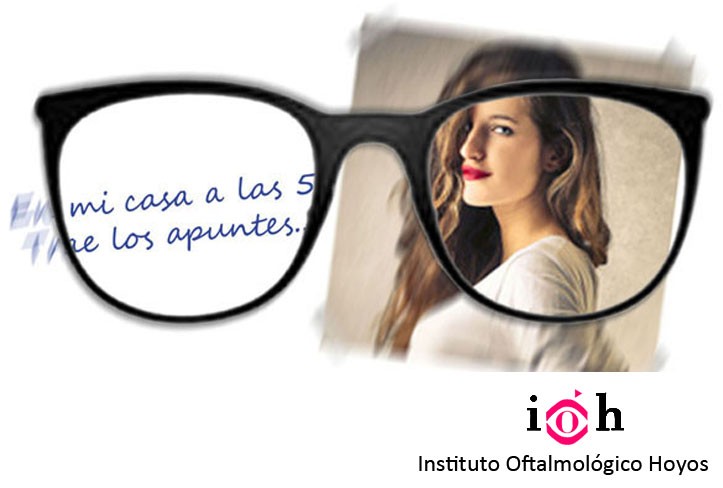Clínica para Cirugía Refractiva: Operación de la vista
En el Instituto Oftalmológico Hoyos, ofrecemos tratamientos avanzados de cirugía refractiva para corregir la visión de forma segura y efectiva. Desde la corrección de miopía, hipermetropía y astigmatismo con Láser (LASIK y PRK) hasta soluciones personalizadas con lentes intraoculares, con resultados óptimos respaldados por tecnología de vanguardia y la experiencia de nuestros especialistas. Descubre cómo podemos mejorar tu visión y calidad de vida sin necesidad de gafas o lentes de contacto.
Qué es la cirugía refractiva
La cirugía refractiva es un conjunto de procedimientos oftalmológicos diseñados para corregir defectos visuales como miopía, hipermetropía y astigmatismo. Utiliza técnicas avanzadas con láser (LASIK y PRK) para modificar la forma de la córnea y lentes y lentes intraoculares. Este tratamiento ofrece a los pacientes la posibilidad de reducir o eliminar la dependencia de gafas o lentes de contacto, mejorando significativamente su calidad de vida visual.

Tipos de cirugía refractiva
La cirugía refractiva se puede realizar de formas distintas dependiendo de cada caso particular, es por eso que estas se pueden diferenciar como con láser o con lente intraocular.
Con láser
La cirugía refractiva con láser es una opción avanzada para corregir defectos visuales como la miopía, la hipermetropía y el astigmatismo. Utiliza tecnología láser de alta precisión para remodelar la córnea y mejorar la capacidad visual del paciente.
Cirugía refractiva LASIK
- Procedimiento rápido y efectivo
- Recuperación rápida
- Alta tasa de éxito
- Versatilidad
Cirugía refractiva PRK
- Corrección sin flap corneal
- Procedimiento superficial
- Menor riesgo de complicaciones
- Adecuado para deportistas y profesiones específicas
Con lente intraocular
La cirugía refractiva con lente intraocular ofrece soluciones avanzadas para corregir problemas visuales que no son adecuadamente tratados con otros métodos. Dos opciones destacadas son:
Implante lente Visian ICL
- Corrección de Alta miopía, hipermetropía y astigmatismo
- Lente removible y reversible
- Resultados rápidos y estables
- Adecuado para casos específicos
Cirugía del cristalino
- Tratamiento de cataratas
- Corrección de presbicia
- Procedimiento personalizado
- Resultados duraderos
Clínica para cirugía refractiva en la zona de Barcelona
En nuestra clínica, nos especializamos en ofrecer soluciones avanzadas de cirugía refractiva para ayudar a nuestros pacientes a obtener una visión clara y libre de gafas o lentes de contacto. Utilizamos tecnología de vanguardia y contamos con un equipo de expertos en oftalmología para garantizar los mejores resultados posibles. Nuestro enfoque integral y personalizado nos permite tratar con éxito una variedad de problemas visuales, proporcionando un cuidado excepcional y resultados duraderos.
Ventajas de elegir nuestra clínica:
- Tecnología de última generación: Empleamos los equipos y técnicas más avanzados en el campo de la cirugía refractiva.
- Equipo de expertos: Nuestro personal médico está altamente capacitado y cuenta con una amplia experiencia en procedimientos de corrección visual.
- Enfoque personalizado: Cada paciente recibe un plan de tratamiento adaptado a sus necesidades específicas y características oculares.
- Seguimiento continuo: Ofrecemos un seguimiento exhaustivo y cuidado postoperatorio para asegurar una recuperación rápida y óptima.
Aplicaciones de la operación de la vista para problemas oculares
La cirugía refractiva ofrece soluciones eficaces para una variedad de problemas oculares comunes que afectan la claridad visual. Desde la miopía hasta las cataratas, cada técnica quirúrgica se adapta para corregir y mejorar la visión según las necesidades específicas de cada paciente. A continuación, exploramos cómo la cirugía refractiva aborda algunos de los problemas oculares más frecuentes.
Miopía
La operación de la vista para la miopía es especialmente efectiva mediante técnicas como LASIK y PRK, puede corregir la miopía al remodelar la córnea, permitiendo que la luz se enfoque correctamente en la retina. Para aquellos con miopía alta o córneas delgadas, el implante de lente Visian ICL ofrece una alternativa eficaz, proporcionando una corrección duradera y de alta calidad visual.
Presbicia
La operación de la vista para la miopía es especialmente efectiva mediante técnicas como LASIK y PRK, puede corregir la miopía al remodelar la córnea, permitiendo que la luz se enfoque correctamente en la retina. Para aquellos con miopía alta o córneas delgadas, el implante de lente Visian ICL ofrece una alternativa eficaz, proporcionando una corrección duradera y de alta calidad visual.
Astigmatismo
Las técnicas de cirugía refractiva como LASIK y PRK son altamente efectivas para corregir el astigmatismo. Estas técnicas suavizan la forma de la córnea, creando una superficie más uniforme para que la luz se enfoque correctamente. En casos donde el astigmatismo es severo, el implante de lentes tóricos intraoculares puede proporcionar una corrección precisa y estable.
Cataratas
La cirugía del cristalino es la solución principal para las cataratas. Este procedimiento implica la extracción del cristalino opaco y su reemplazo con una lente intraocular clara. Las lentes modernas pueden no solo restaurar la visión clara, sino también corregir errores refractivos como la miopía y el astigmatismo, proporcionando una visión mejorada a múltiples distancias.
Consideraciones de la cirugía refractiva
Antes de decidir someterse a una cirugía refractiva, es crucial comprender las diversas consideraciones asociadas con este tipo de procedimiento. La cirugía refractiva ofrece una solución eficaz y permanente para corregir problemas de visión como la miopía, la hipermetropía y el astigmatismo, pero también es importante estar bien informado sobre los riesgos, el tiempo de recuperación y los costos involucrados. A continuación, exploraremos estos aspectos clave para ayudar a los pacientes a tomar una decisión informada y segura.
Riesgos de la cirugía refractiva
Aunque la cirugía refractiva, como LASIK, PRK y el implante de lente intraocular, tiene una alta tasa de éxito, todos los procedimientos médicos implican ciertos riesgos. Algunos de los riesgos asociados con la cirugía refractiva incluyen:
- Complicaciones durante el procedimiento: Aunque son raras, pueden ocurrir complicaciones durante la cirugía, como infecciones o problemas con el flap corneal en el caso de LASIK.
- Resultados visuales no deseados: Algunos pacientes pueden experimentar halos, deslumbramientos o una visión nocturna reducida, especialmente en los primeros meses después de la cirugía.
- Sequedad ocular: Es común experimentar sequedad ocular temporalmente después de la cirugía. En algunos casos, esto puede convertirse en una condición crónica que requiere tratamiento continuo.
- Resultados subóptimos: En ciertos casos, la corrección visual puede ser insuficiente, lo que podría requerir una segunda cirugía o el uso continuado de gafas o lentes de contacto.
Es fundamental discutir estos riesgos con el cirujano y realizar una evaluación completa para determinar si uno es un buen candidato para la cirugía refractiva.
Tiempo de recuperación de la cirugía refractiva
El tiempo de recuperación después de la cirugía refractiva varía según el tipo de procedimiento realizado. A continuación, se detallan los tiempos de recuperación típicos para algunos de los procedimientos más comunes:
- LASIK: La mayoría de los pacientes experimentan una recuperación visual rápida, con una mejora significativa de la visión en las primeras 24 a 48 horas. La recuperación completa puede llevar unas pocas semanas, durante las cuales es esencial seguir las indicaciones postoperatorias del médico.
- PRK: A diferencia de LASIK, PRK tiene un tiempo de recuperación inicial más prolongado. Los pacientes pueden experimentar molestias y una visión borrosa durante los primeros días, y la recuperación completa de la visión puede tardar varias semanas.
- Implante de lente intraocular (ICL): La recuperación es generalmente rápida, con mejoras visuales notables dentro de las primeras 24 a 48 horas. La estabilización completa de la visión puede tomar algunas semanas.
- Cirugía del cristalino: La recuperación puede variar, pero los pacientes suelen ver mejoras visuales significativas en pocos días, con una estabilización completa en unas pocas semanas.
Durante el periodo de recuperación, es crucial evitar frotar los ojos, seguir las instrucciones de cuidado postoperatorio y asistir a todas las citas de seguimiento para asegurar una recuperación óptima.
Precio de la cirugía refractiva
El costo de la cirugía refractiva puede variar considerablemente dependiendo de varios factores, incluyendo el tipo de procedimiento, la clínica seleccionada y la ubicación geográfica. A continuación, se presentan algunos aspectos que influyen en el precio:
- Tipo de procedimiento: Las técnicas como LASIK y PRK suelen tener precios diferentes, y procedimientos más avanzados como el implante de lente intraocular pueden ser más costosos.
- Experiencia del cirujano: Los cirujanos con más experiencia y una alta reputación pueden tener honorarios más altos, pero esto a menudo refleja una mayor seguridad y calidad del tratamiento.
- Tecnología utilizada: Las clínicas que utilizan la tecnología más avanzada para procedimientos de láser o implantes de lentes pueden tener costos más elevados debido a los beneficios adicionales que estas tecnologías pueden ofrecer.
- Cobertura del seguro: En muchos casos, la cirugía refractiva es considerada un procedimiento electivo y no está cubierta por el seguro. Es importante consultar con el proveedor de seguros para entender la cobertura disponible.
Los precios pueden oscilar desde unos pocos miles de euros por ojo hasta cifras más altas dependiendo de las variables mencionadas. Es aconsejable consultar con la clínica directamente para obtener un presupuesto detallado y discutir las opciones de financiamiento disponibles.
Preguntas frecuentes sobre cirugía refractiva
